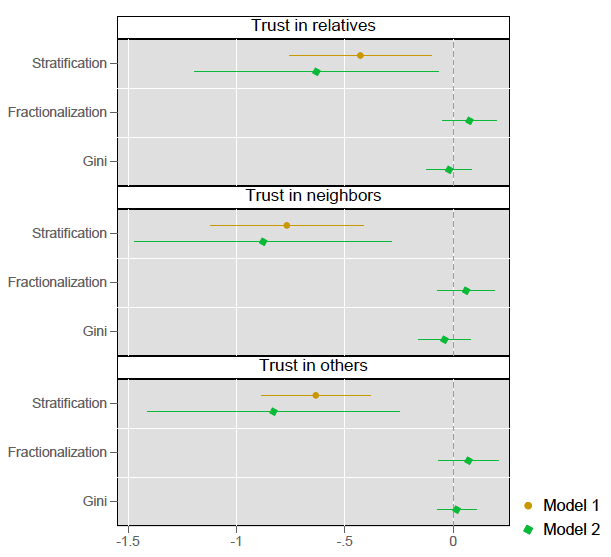
A new index of ethnic stratification reveals that ethnic differences matter for conflict if, and only if, they coincide with economic differences
Predicting social conflict
What are the determinants of social conflict, be it in the form of mistrust within a community or tragic outbreaks of organised violence? Conflict and contact theory both play a prominent role in addressing this crucial question. Conflict theory predicts that diversity and interactions between distant ethnic groups can lead to perceived threat, greater antagonism, mistrust, and conflict. There is considerable evidence that ethnic diversity (typically measured by indices of ethnic fractionalisation or polarisation) indeed leads to higher social conflict (e.g. Alesina and La Ferrara 2000, Montalvo and Reynal-Querol 2005, Esteban et al. 2012). In contrast, contact theory, which goes back to Allport (1954), states that intergroup contact can reduce prejudice towards other groups and, thereby, increase trust and reduce conflict. However, Allport expected this positive outcome only if ethnic groups had “equal status” (i.e. are socioeconomically similar). Hence, conflict and contact theory are not mutually exclusive: they are both consistent with social conflict between interacting ethnic groups if such groups are hierarchically ranked by their economic status. Some recent studies indeed find that higher levels of between-group inequality are related to less trust (Tesei 2017) and more conflict (e.g. Cederman et al. 2011).
A new index of ethnic stratification
In a recent paper, we proposed an index of ethnic stratification as a predictor of social conflict (Hodler et al. 2020). This index is based on the idea of between-group inequality but offers a more sophisticated account of the interaction between ethnic diversity and economic inequality: it measures the extent to which the hierarchy in socioeconomic positions follows ethnolinguistic lines. Our index is based on interactions between pairs of individuals. A key assumption is that the degree of alienation or mistrust between pairs of individuals depends on their economic and ethnolinguistic distances. Economic distance is the difference in economic resources between two individuals, and ethnolinguistic distance the dissimilarity of the languages they speak (e.g. Fearon 2003, Desmet et al. 2009). To be more specific, the alienation of each pair of individuals equals the product of their economic and ethnolinguistic distances.1 By weighting ethnolinguistic differences between pairs of individuals by their economic distances, our index is a generalisation of ethnic fractionalisation. Symmetrically, by weighting economic inequalities by ethnolinguistic distances, it generalises between-group inequality. Our index of ethnic stratification depends on two crucial properties of economic and ethnolinguistic distances:
- Their overall magnitude, as measured by the index of generalised ethnic fractionalisation and the Gini coefficient of the wealth distribution (multiplied by average wealth);
- Their co-directionality, i.e. the extent to which these distances correlate across pairs of individuals.
The Igbos in Nigeria
The experience of the Igbos in Nigeria illustrates the importance of ethnic stratification. After independence, many Igbos were relatively well-educated because of the efforts of Christian mission schools. Since there were few economic opportunities in their native Eastern Region, they migrated to other regions of Nigeria. The resulting ethnic stratification was higher in towns in the Hausa-dominated Northern Region than in towns in the Yoruba-dominated Western Region for two reasons:
- The ethnolinguistic distance between Igbo and Hausa is much larger than that between Igbo and Yoruba.
- The economic (in particular the educational) distance also tended to be greater between Igbo migrants and natives in the Northern Region, where the local Muslim elite opposed Christian missions, than in the Western Region. Mistrust and intergroup violence increased dramatically after two military coups in 1966, especially in the Northern Region where “[a]ll the envy, resentment and mistrust that Northerners felt for the minority Eastern community living in their midst burst out with explosive force into a pogrom” (Meredith 2005: 202). While far from peaceful, violence against Igbos was less extreme in the Western Region, where Igbo in-migration had not raised ethnic stratification to the same extent as in the Northern Region.
Measuring ethnic stratification across Africa
Inspired by this example, we investigate whether ethnic stratification is a predictor of social conflict in African towns and villages. For this purpose, we use geocoded individual-level data from Afrobarometer surveys (BenYishay et al. 2017, Afrobarometer 2018) conducted in 26 ethnically diverse African countries between 2011 and 2013. We use data from 21,379 respondents to measure ethnic stratification in 2,558 towns and villages. We merge the respondents’ languages and ethnicities to the Ethnologue database (Gordon Jr. 2005), which is modelled as trees that show the historical relation between all languages. This allows us to compute ethnolinguistic distances between individuals. To get a measure of economic distances, we construct a wealth index based on information on assets a respondent's household possesses. Given ethnolinguistic and economic distances between any two respondents, we can compute ethnic stratification for our towns and villages.
Ethnic stratification, trust and violent conflict: The evidence
We find that individuals living in towns and villages with higher ethnic stratification are less likely to trust their relatives, neighbours and other acquaintances (Model 1 in Figure 1): an increase in ethnic stratification by one standard deviation coincides with a reduction in the probability that a respondent trusts her relatives, neighbours and others by 1.4, 2.5 and 2.1 percentage points, respectively.
Figure 1 The effects of ethnic stratification on trust

Notes: This figure plots the point estimates and 95% confidence intervals of two regressions/models, which both include interacted country-ethnic group fixed effects and a rich set of individual and geographical control variables.
Our results for ethnic stratification remain robust to including ethnic fractionalisation, the Gini index, and average wealth in the regression (Model 2 in Figure 1). Furthermore, ethnic fractionalisation and the Gini index themselves do not have an effect on trust. Consistent with both contact and conflict theory, these results suggest that ethnolinguistic distances between individuals are predictive of mistrust but only if the ethnolinguistic distances go hand-in-hand with economic distances. Along the same lines, we also document that ethnic stratification is positively related to the respondents' fear of crime and to nearby violent conflict events.
Conclusions
Our results confirm that ethnic stratification is a good predictor of social conflict. They therefore emphasise the importance of taking socio-economic hierarchies along ethnolinguistic lines into account. Our index can be used in future research to shed light on the importance of socio-economic hierarchies along social dimensions other than ethnicity, such as caste, religion, or cultural values.
References
Afrobarometer (2018), “Sampling principles and weighting” (retrieved 3 July 2018).
Alesina, A and E La Ferrara (2000), “Participation in heterogeneous communities”, Quarterly Journal of Economics 115, 847-904.
Allport, G W (1954), The Nature of Prejudice, Addison-Wesley.
BenYishay, A, R Rotberg, J Wells, Z Lv, S Goodman, L Kovacevic and D Runfola (2017), “Geocoding Afrobarometer rounds 1-6: Methodology & data quality”, Williamsburg, VA: AidData at William & Mary. (retrieved 20 November 2018).
Cederman, L, N Weidmann and K Gleditsch (2011), “Horizontal inequalities and ethnonationalist civil war: A global comparison”, American Political Science Review 105(03): 478-495.
Desmet, K, S Weber and I Ortuno-Ortin (2009), “Linguistic diversity and redistribution”, Journal of the European Economic Association 7(6): 1291-1318.
Esteban, J, L Mayoral and D Ray (2012), “Ethnicity and conflict: An empirical study”, American Economic Review 102 (4), 1310-1342.
Fearon, J (2003), “Ethnic and cultural diversity by country”, Journal of Economic Growth 8(2): 195-222.
Gordon Jr., R G (ed.) (2005), Ethnologue: Languages of the World, 15th edition, SIL International.
Hodler, R, S Srisuma, A Vesperoni and N Zurlinden (2020), “Measuring ethnic stratification and its effect on trust in Africa”, Journal of Development Economics 146, article 102475.
Meredith, M (2005), The state of Africa: A history of fifty years of independence, Free Press – Simon & Schuster.
Montalvo, J G and M Reynal-Querol (2005), “Ethnic polarization, potential conflict and civil wars”, American Economic Review 95(3): 796-816.
Tesei, A (2017), “Trust and racial income inequality: Evidence from the US”, Working paper.
Endnotes
1 Our index is part of a class of bivariate measures that are expressions of the expected alienation between a randomly selected pair of individuals. We present an axiomatic characterisation that uniquely identifies our index from this class via a set of axioms that we motivate as desirable properties of a measure that generalises between-group inequality.




